c. 1859 -1861 Hernstein
Surgical Set
Owned by W. T. Jordan,
MD Confederate States Army
The maker, H. Hernstein of New York, was located at 393 Broadway
(address on the capital saw) during the Civil War period 1862-1865. Shown
here is an extensive surgical set of the type which could have been used in the
field during the Civil War. It is a civilian surgical set, with center
lock, but containing an early style bullet forceps, male urethral sounds, early
Satterlee bone forceps, ivory handled scalpels, Galt style trephine, which helps identify the possible use of
the set. The address on the instruments means
the set was made between 1862 - 1865 and most likely was purchased by the owner
during that time after he left the Confederate Army or as surplus after the War. Hernstein was
located at the following addresses according to
Edmonson:
Hermann Hernstein surgical instruments, NY
1843:
3 Chambers
1844: Elizabeth cor. Hester
1845-48: 7 Hague
1850: no listing
1851-52: 68 Duane
1853-54: 81 Duane
1855-57: 81 Duane and 393 Broadway
1858: 81 Duane, 131 Mercer, and 393 Broadway
1859-61:
131 Mercer and 393 Broadway
Hermann Hernstein & Son (Hermann and Albert L. Hernstein) 1862-65:
131 Mercer and 393 Broadway
Hermann Hernstein & Son & Co. 1865:
2 Liberty and 393 Broadway
Hermann Hernstein & Co. 1866-67:
2 Liberty and 393 Broadway
The top of the case is
crudely
marked with the owner's name 'W.T.Jordan,
M.D' Nansemond
County VA, it is not engraved.
William Turner Jordan
(1835-1922), went to and graduated from medical school prior to the Civil War,
but is not listed as having served as a medical officer or surgeon during the
War. He attended the University of Virginia medical college from
1855-1856, then graduated from the University of New York, Medical Department in
1859 and was practicing in Driver, VA until 1890. It is certain he
enlisted in the Confederate Army, it is certain he served as an infantry officer
and was a prisoner of war. He would have been a practicing doctor during
the early part of the War when this set was made. He could have purchased
it when the War started as it is possible this Hernstein configuration was made
in the first years of the War.
Dr. Jordon was born on 13 Nov. 1835., Occupation: Physician. His service record states: Enlisted as a
lieutenant 2nd class on 21 of April 1861 in Hargroves Tavern, Va., Commission in Co. F, 3rd Inf. Va. on 21 April 1861.
Resigned on 17 Sept. 1861. Fought in 3 battles. (It is unknown if he worked as a contract surgeon
after resigning in Sept. 1861, but that is entirely possible. Given the
known dates of the manufacture of the set by Hernstein, it is highly likely the
owner, W. T. Jordan owned this set prior to the Civil War unless he purchased it
post-War as surplus when he went back into private practice.
Please go
here for additional information on Jordan and a note sent to W. T. Jordan's
children regarding his wartime where-abouts,
which do not totally agree with the war service record cited above. There is much
confusion about Jordan's war record as he does not show up as having been in the
areas he mentions in the note to his children. The account for Pryor's 3rd
Brigade doesn't list any Lt. W. T. Jordan. Then there is the odd situation
of him serving in the signal service? And, being a prisoner of war.
It is generally believed a Confederate
surgeon held the rank of Maj. or better, but The Confederate Medical Department
states: "...there were a number of contract surgeons or acting assistant
surgeons, with the pay of a second lieutenant of infantry, who were temporarily
employed, nearly all of these, however, at some period....were commissioned or
dropped from the Army rolls. Click here for full text of this information
on the
Confederate Medical
Department organization.
The large mahogany case
measures 17 x 9 1/2 x 4 inches and is lined with red velvet. There is one
removable tray, The set includes instruments for: trepanning, eye
surgery, amputation, urology, and oddly enough...ear surgery. The
set is civilian issue, but contains a bullet forceps, and urinary sounds, both
of which would be found in military sets of the era.
See a
comparison
of two Civil War era surgical sets by Hernstein.
Click any photo to enlarge


Dr. W.T.Jordan,
Nansemond County VA
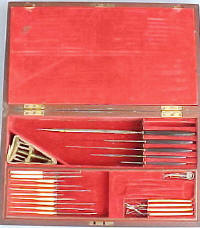
Case open with divider and tray in place
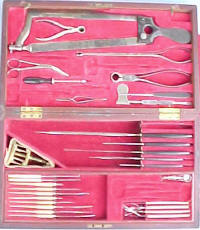
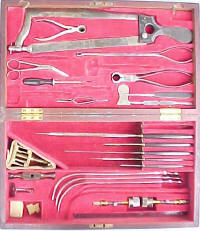
Upper and lower sections with removable tray in
place and removed
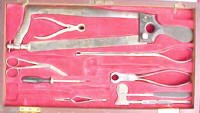
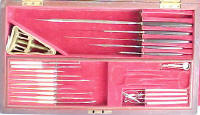
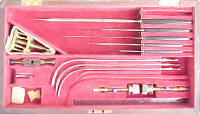
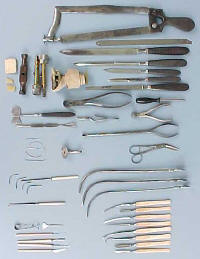
All instruments in the case
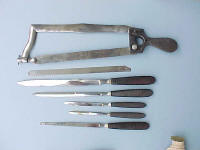
Typical war-time capital
saw, with straight blade amputation knives, and ferrules formed in the blade

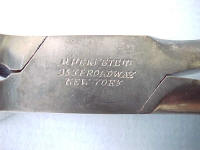

H. Hernstein name and address (393 Broadway)
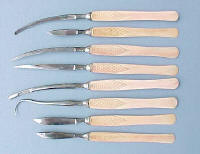
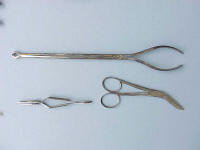
Cross-checked ivory handles on scalpels, bullet forceps, upper right
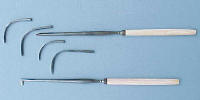
Aneurism suturing needles with handle
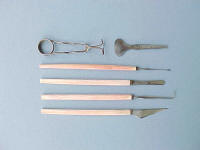
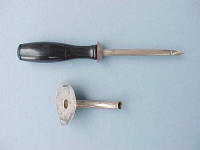
Eye surgery instruments
Trocar and tracheotomy tube
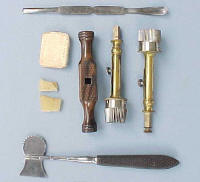
Trepanning instruments, crown type trephine, c. late 1850's or early
1860's
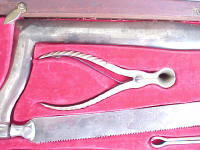
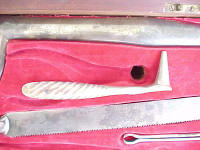
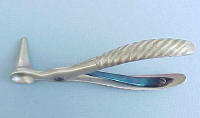

Ear speculum with blued spring (marked Hernstein)
made of German silver


Satterlee bone forceps, typical for the earliest years
of the War


Early style bullet forceps
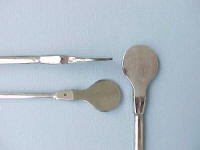
Urethral sounds for males are an early design
and unmarked
Compare the instruments in the
large
Hernstein set (above) with those in a Hernstein U.
S. A. Hosp. Dept. marked minor surgery set below.
Curious how similar the instruments are from the two makers,
Hernstein in New York, and Gemrig in Philadelphia...Hmmmm could it
be the French influence?
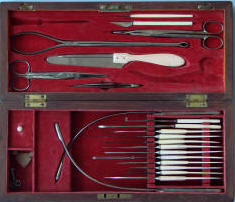
Also see the
partial set
Gemrig
minor surgery set. (below) for comparison.
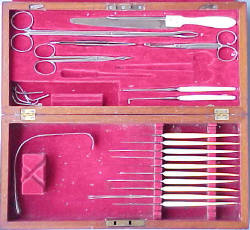
Display 1 |
Display 2 |
Display 3
Display 4 |
Display 5 |
Display 6
|